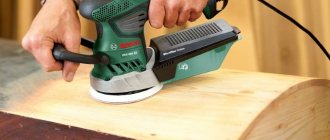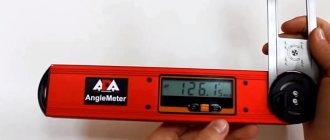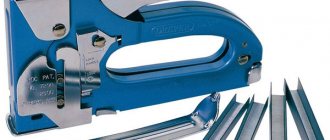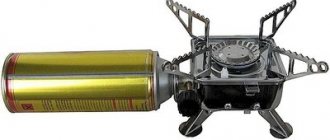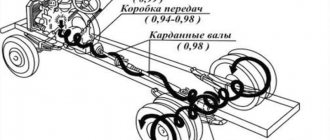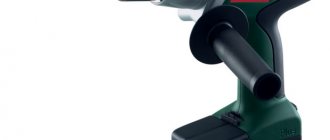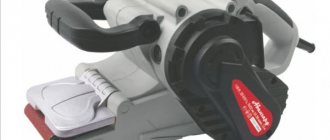Hand-held power tools for abrasive processing of surfaces of products and building structures are collectively called a grinding machine, or grinder. The terms are firmly established in everyday life, although this category also includes devices that perform cutting work, finishing polishing and cleaning surfaces from rust and old paint. Most sanders are electric, although pneumatic tools are also used in industrial production.
There are five main types of grinding machines, which differ from each other in the movement of the abrasive material and the design of the working body. Four of them are designed for polishing, grinding and other similar work, and one can also work with cutting wheels. All these tools are presented in specialized stores in a large assortment and a wide range of prices. At the same time, the answer to the question of how to choose a suitable grinding machine from such a variety will always sound approximately the same: first of all, you need to determine your needs, and then understand the purpose of the machine and the principles of operation. Images of the main types of hand-held power tools are presented in the figure below (delta refers to vibrating machines), and a brief description of each of them will be given below.
The most popular types of grinders
Direct.
Ideal for sanding surfaces in difficult to reach areas. This is due to the presence of a long proboscis on the instrument, at the end of which the equipment is fixed. The spindle in such a grinder is located along the axis of the body, which explains the name. It is available in both electric and pneumatic versions - the latter option copes better with cleaning welds and removing edge burrs, while for leveling surfaces it is better to buy an electric grinder.
How does a household appliance differ from a professional one?
There are several main differences that are undoubtedly worth paying attention to when choosing a tool:
- Working hours. The household tool can be used without stopping for five to ten minutes, after which the machine should be allowed to cool for some time. A professional model can work from fifteen to twenty minutes, and she needs literally five minutes to rest.
- Terms of use, level of protection. It is immediately clear that a more serious instrument (professional) will look better in relation to the “amateur” one. It will better “swallow” dust and moisture, and “steadfastly” withstand wire breakdowns and long-term operation.
- Durability. For a household tool, it will be enough to work for two to three hours a day and that’s it, but a professional tool can withstand two full-fledged work shifts.
In addition, a professional tool has additional “bells and whistles,” but a household model may have them, but only a top-tier tool. It is clear that the manufacture of serious power tools requires high-quality materials and excellent fittings.
And they are several times more expensive compared to household ones. Most well-known manufacturers make it easier for their customers to choose by releasing instruments on store shelves where the body is made in different colors. For example, Bosh, blue is professional, green is amateur.
Polishing machine
The polishing machine is mainly used for polishing vehicle body parts. Such a grinder is practically a grinder, but with some differences:
- the spindle is capable of rotating at low speeds - at least 800 rpm;
- the handle is located parallel to the working disk;
- the presence of a speed controller and the function of maintaining them at the set value even under load.
Polishing grinding machine with speed control
Manufacturers produce models of polishing grinding machines that operate both from the mains and from a battery. The second option is designed to perform short-term work for approximately 30 minutes. After this, the battery of the polishing machine is recharged.
Decisive factors when choosing
Before you start choosing a grinding machine, you should decide what it will be used for and under what conditions it will be used.
Not only its technical characteristics will depend on this, but also the price, as well as the cost of consumables and possible repairs. For example, if you just need to clear the old paint from the floors in your dacha and tidy up the porch before painting, then a belt sander costing several thousand rubles with more or less good reviews will be quite suitable. If the machine is chosen for a home workshop, in which it is planned to make furniture and interior items, then, most likely, you will have to choose a decent orbital sander with good performance and speed control. But regardless of what type of machine you plan to purchase, when choosing it you need to pay attention to a number of important factors:
- Abrasive speed. It must match the type of material being processed, or the machine must have a speed controller.
- Consumption and cost of abrasive and operating materials. For example, one of the problems with some branded models is the difficulty in purchasing and the high price of sole pads.
- The need for autonomous battery power.
- Ergonomics, including additional handles.
- Availability of a standard pipe for a vacuum cleaner or adapters.
- Noise and vibration levels. These characteristics can only be found out from user reviews.
- Guarantee period. It can range from one year to five years and is subject to mandatory periodic maintenance at company centers.
In addition, you should definitely pay attention to the cost of delivery and the proximity of warranty workshops.
Some people buy grinding machines for several thousand rubles on the principle: “if it breaks, I’ll throw it away and buy a new one.” Others, even for one-time work, prefer to purchase advanced models costing more than ten thousand rubles. What position do you take? Please write about this in your comments to this article.
Applications of angle grinders
The most commonly purchased tool of this type for household use is the so-called “grinder”, with which you can cut, clean, and grind various surfaces. Almost every owner has such a tool at his disposal. With its help, quite a lot of work is done in the house and on the plot. A grinder is indispensable if any structure is being built; it will help bring old pots and pans into a shiny appearance. Different wheels are used for cutting different materials; for roughing, grinding and polishing, metal brushes, emery or eccentric attachments are used, which can be used to sand wood, metal and plastic.
Angle grinder
An angle grinder is a universal, productive power tool with a side handle, which is commonly called an angle grinder. In the front part of its narrow body, a disk-shaped accessory is fixed. Inside the machine there is an electric motor and an angular gear train.
The disc is fixed on the spindle, which is located perpendicular to the body of the angle grinder. That's why the tool is called an angle grinder. When attaching the equipment, a flange and a threaded clamping nut are used.
Attaching the attachment to the angle grinder spindle
Abrasive discs are used as equipment for an angle grinder for processing metal and ceramic materials. Brushes are also used to clean surfaces. To sand wood, use disc and flap wheels with sandpaper of the required grain size. Large surfaces are cleaned with a grinder. It is not suitable for working in corners or tight spaces.
Using an angle grinder, perform:
- peeling of paint and varnish material;
- rust removal;
- smoothing out irregularities.
On a note! When sanding concrete walls and floors, an angle grinder must be used in conjunction with diamond cups.
Angle grinder with diamond cup installed
Vibratory and eccentric sanding machines
Vibratory grinding and eccentric grinding are similar in principle of operation. The engine drives an eccentric connecting rod, which is located on the shaft. The eccentric transmits oscillatory movements to the working sole, which actually removes the layer of material being processed. We can say that grinding occurs with a certain amplitude. The only difference between the VShM and the eccentric one is in the shape of the sole: the VShM is flat and can only be used to polish flat surfaces, while the eccentric one is round and is also suitable for wavy surfaces.
Vibratory Surface Grinder
The vibrating machine is a surface grinding power tool with a soft base. On top of it is a plastic case with an electric motor, the operation of which ensures the reciprocating movements of the eccentric mechanism. Due to this, the sole of the sanding machine vibrates, moving along an arc with a small radius.
Sander with soft abrasive base
With the help of a vibrating surface grinder, finishing sanding is carried out over a large area, processing corners thanks to the rectangular design of the base. Manufacturers make it with standard (10*20 cm) and miniature (10*10 cm) soles. Sandpaper is fixed to a base of any size using a clamping mechanism or Velcro. Its grain size is selected depending on the surface being processed.
Vibrating sander with clamping mechanism for abrasive
Selecting Sanding Paper
At different stages of sanding, as well as for different types of wood, it is necessary to use an abrasive cloth with different levels of grain size.
Sandpaper organizer
The grit of sandpaper, roughly speaking, can be considered the density of the grains - the number of particles of abrasive material spent on filling one square inch of surface.
The grit size can be determined by the markings on the back of the abrasive blade - this is the number indicated after the letter “P”. The higher the number, the finer the abrasive material and vice versa, the lower the number, the larger the grain.
Dependence of the type of work on the grain level:
- 22 - 36 - rough primary work;
- 40 - 60 - rough grinding;
- 80 - 120 - primary grinding;
- 150 - 180 - final grinding;
- 240 - 280 - grinding hard rocks;
- 400 - 600 - polishing;
- 1200 - 1500 - final polishing.
When working with wood, you cannot get by with sandpaper with one level of grit. If the board is sanded immediately after sawing, then you need to first go over it with P40, P80 blades for rough sanding. If the board is smooth enough, then you can immediately begin fine processing with blades P120, P240.
Sandpaper with different grits
Basically, this is enough to prepare the wood surface for painting or varnishing. But, if initially there is heavy contamination on the surface, an old rotten layer of wood, then it is better to start with P24 paper.
If it seems that the result after sanding P240 is not satisfactory, and you want a smoother surface, then you can sand it with P400 sandpaper. But no more, because Then polishing of the surface will begin, which may negatively affect the further process of priming and painting. Due to the fact that the surface will be perfectly smooth, adhesion will suffer, and the paint may then simply peel off.
Brush sander
There are two handles on the body of the brush sander. One of them is the main one, and the second is auxiliary, providing precise control. The design also includes a mandrel shaft designed to accommodate ring-shaped equipment.
The design of the brush sander also allows you to attach a cylindrical nylon brushing brush, with the help of which it will be possible to create an aging effect on the wood. Depending on the material being processed and the purpose of the work performed, a metal or composite nozzle can also be installed.
Brush sander with cylindrical attachment
A brush sander is used to finish the boards before applying paint or varnish. After its use, the structure of the wood becomes clearer and becomes more distinguishable. A brush sander is also effective in removing rust from metal surfaces.
Exploitation
After completion of work, the grinder should be thoroughly cleaned and the moving parts periodically lubricated. If the dust collector becomes worse at collecting dust, it is necessary to disassemble and clean it.
It is recommended to use consumables with the characteristics declared by the manufacturer. It is necessary to ensure that the power cord does not enter the working area of the device and prevent overheating of the equipment. The device should be stored in a dry, heated room.
All these measures will prevent rapid wear of the machines.
When working with equipment, you should follow safety precautions and use safety glasses and a dust respirator.
Crosscut, straight model
They are the simplest of this category of tools. Used for minor work - trimming, stripping, sanding. In appearance it is an elongated body with an electric motor.
In this case, the working element is sanding attachments in the form of a cylinder, cone, or sphere of not very large shape. Both cutting and flap discs can also be used.
Accessories and attachments
The price of a manual grinder makes you think about the need to purchase it, and many try to make an analogue from an angle grinder, a drill, or a homemade device.
There are special attachments for both angle grinders and drills that allow you to grind wood.
Velcro disc for grinder
To sand wood with a grinder, use special wheels with Velcro for sandpaper.
When grinding, the grinder is moved in different directions with careful movements. The grinding wheel breaks due to a collision with a nail head or sudden movements. Using paper of different grain sizes, you can carry out rough and medium sanding of a wooden surface. At the same time, the work speed will be faster than with other grinding machines.
It will be difficult to complete finishing work because... She needs to work very carefully so as not to damage the product. The tool will constantly be pulled to the side and pulled out of your hands.
The nozzle does not have dust removal, which is why debris will constantly accumulate under the sandpaper and interfere with work, leave scratches, and reduce speed. The disc is cleaned by grinding the metal for several seconds. During this time, all adhering dust particles burn out.
Drill attachment
To adapt a drill for grinding work, you will need a special attachment, similar in design to the attachment for an angle grinder - a sanding plate. Often the nozzle comes complete with an adapter so that it can be installed both in the chuck of a drill or screwdriver, and on an angle grinder.
Working with a drill with such an attachment is very difficult, more difficult than with an angle grinder. She is constantly being driven, the drill is being pulled out of her hands in such a way that she can get injured or sprained. The disadvantages that were listed above in the chapter about the attachment for angle grinders are also relevant.
But, if there is no other choice, then it is better to find a grinding plate that has soft rubber between the sole and the mount, which will bend easily if the drill is not held level.
Grinding attachment for drill flexo fix
This floating effect of the nozzle will somewhat simplify the grinding process, but will not eliminate all the other disadvantages of this method.
Homemade sanders
If you wish, you can make your own belt-type grinder - a grinder. But this process is labor-intensive and traumatic, requiring skills in working with wood, metal, electricity, and welding skills will come in handy.
Stages of creating a homemade grinder:
- Find the necessary materials: metal scraps, springs, rollers, bearings, electric motor and wires.
- They make a solid base for attaching the device.
- Install a tabletop that is suitable in size.
- Parallel stands with an electric motor and a drum with a sanding belt tensioner are installed.
- The drums and electric motor are assembled and attached.
- Install the sanding belt.
Flat
Surface or vibratory sanders are so called because they have a flat base. And grinding is carried out due to high-frequency vibration of the platform. Very often used for sanding large wooden surfaces of tables, cabinets and others. Sanding strips of the required grain size are attached to the platform with clamps in front and behind, with which the work is carried out.
Features of planetary tools
In practice, it is often necessary to polish products made of artificial or natural stone. A similar need arises, for example, when installing window sills, decorative fireplaces, and stone countertops.
The planetary grinder has a massive body, inside of which there is a fairly powerful motor. The working part is represented by a grinding plate with a planetary type of action.
For high-quality processing of stone surfaces, special diamond-coated plates are used. Also in the lower part there are holes for water supply (cooling of the processed material).
All modern models of planetary machines are equipped with nozzles that can be connected to a vacuum cleaner to remove stone dust and crumbs.
Deltoid Sanding Machine
The main difference between this type of sander is the deltoid shape of the working sole, which is similar to an iron. A lightweight body without handles is placed above the triangular sole. The design of the delta-shaped grinder allows you to process hard-to-reach areas.
Deltoid sander with triangular sander
Grinding with a deltoid machine is performed thanks to rapid movements of the sole with a small amplitude. This allows you to get high-quality results even on difficult-to-process materials. Models of delta-shaped grinder with a rotating working platform are available. Due to this design, it is possible to quickly change the angle of the abrasive nozzle if it is worn out during the grinding process. This is relevant, for example, when fulfilling an urgent order. The equipment is fixed on the working platform using Velcro.
Delta sander with rotary pad
Orbital or eccentric sander
An orbital sander is also known as an eccentric sander, which allows you to process the surface better than a flat vibrating tool. This is because the orbital sander both rotates and vibrates. The combination of movements of the sole in different directions ensures that surfaces are processed without marks left by an angle or belt sander.
Orbital sander with round pad
On the sole of the sander, round abrasive elements with a felt base are attached with Velcro, which allows you to quickly and conveniently change discs. If polishing is necessary, a fur or felt attachment is installed on an orbital sander.
Important! For effective dust removal, it is necessary that the holes on the abrasive disk and the working base of the orbital sander coincide.
For dust removal, the holes in the grinder base and the abrasive must match
The orbital sander can be used to finish even curved surfaces. The ability to carry out high-quality grinding is confirmed by the fact that this tool with an amplitude of 3 mm is used in auto repair shops. It is used when preparing vehicles for painting and during polishing work. If you plan to perform standard grinding, then an orbital sander with an eccentric stroke of 5 mm is suitable.
Orbital sander with 3mm base movement
Belt sander
In a belt sander, the body with the electric motor is located on a wide rectangular base with a center of gravity shifted downward. Therefore, horizontal surfaces are processed with minimal physical effort. Power tools are also used for cleaning vertical planes.
Belt machine for grinding surfaces
For belt sanders, the working abrasive element is a strip of sandpaper with the ends connected to each other. Therefore, the equipment has the form of a ring that fits onto two end rollers, with only one of them being the drive one. The movement of the abrasive ring is carried out along the plane of the sole, which ensures that the sandpaper is pressed against the surface being treated. Due to the endless rotation of the glued tape at high speed, it is quickly possible to:
- clean the top layer of wood;
- round the corners of the part;
- align the edge of the workpiece;
- get rid of rust from flat metal;
- remove the height difference between two connected wooden parts;
- remove paint and varnish material from metal and wooden surfaces.
Removing Old Paint from a Table
Manufacturers make three main belt sander standards. A ring of sandpaper of a specific length is put on each of them - 45.7, 53.3 and 61 cm. All these types of sanders leave longitudinal small grooves on the surface being processed. To reduce the depth of scratches on wood, it is recommended to sand along its grain.
Emery ring-shaped abrasive of different grain sizes for a sander
Main types
How to choose a grinding machine? The following main types of grinding machines are distinguished.
Angle grinder (angle grinder or grinder)
This tool is designed for processing stone, metal, ceramics and concrete. The design of the angle grinder involves the location of the working shaft at an angle to the plane of the electric motor. Using a special abrasive disc, grinders successfully eliminate corrosion, cut ceramic tiles, and clean welds.
The angle grinder is designed for processing stone, metal, ceramics and concrete
A large number of special attachments provide a wide range of angle grinder applications. When choosing an angle grinder, it is recommended to pay attention to the weight of the tool and the length of the spindle.
Straight grinder (engraver)
This is a multi-functional tool used for high-precision work. The engraver consists of a housing, an electric motor and a gearbox with a spindle.
The straight grinder is used for high-precision work
Scope of application: grinding, cutting, drilling, engraving, sharpening and other work. Engravers can be equipped with a variety of brushes, grinding stones, cutting wheels, etc. Straight grinders are characterized by their small size, thanks to which they are able to work effectively in confined spaces.
Belt sanding machine (LSM)
This tool is designed for rough grinding, roughening the surface and removing a large layer of material. It is used in construction, carpentry, and carpentry. The belt sander can work on plastic, metal, wood and other materials. The principle of operation of the device involves the movement of the sanding belt along guide rollers. The low center of gravity of the blade ensures minimal effort during operation.
The belt machine is designed for rough grinding
Note! Household belt sanders can have the following basic belt parameters: width - 76 mm, length - 457 mm, 533 mm and 610 mm. To level small surfaces, it is recommended to choose a tool with a short tape length.
Brush grinder
A distinctive feature of this tool is the presence of a metal brush instead of sandpaper. The brush sander can effectively process different types of surfaces: metal, wood and glass.
Feature - the presence of a metal brush instead of sandpaper
The tool is designed to perform large volumes of work: structuring wood, sanding wooden and parquet floors, removing paint and varnish, ensuring a smooth surface.
Eccentric (ESHM or orbital)
The main feature of such a grinder is the presence of an eccentric, which allows you to simultaneously perform circular and reciprocating movements. Scope of application: cleaning, grinding and polishing of profile, volumetric and curved objects. Orbital machines can have sheets of different grain sizes for working on surfaces made of plastic, wood and metal.
The machine simultaneously performs circular and reciprocating movements
ESMs can be of two types: with a classic handle (processing large surfaces) and with a handle for one palm (delicate work).
Vibratory (surface grinding)
Used for cleaning plastic, wood, stone, metals, composite materials. Widely used in furniture repair, woodworking, body repair.
Used for cleaning plastic, wood, stone, metals
The vibratory sander is driven by an electric motor, which transmits oscillatory movements through an eccentric connecting rod to the actuator (sole). The grinding process is carried out using abrasive sheets, which are attached to the surface of the sole with clamps or Velcro.
Delta sander
In terms of its operating principle, this grinder is similar to the vibrating model. However, the delta sander has a different shape of the working element, which is made in the shape of a delta (triangle). This tool is designed for processing hard-to-reach areas, such as recesses and bulges.
The delta sander is suitable for hard-to-reach places
The advantages of the delta sander include its low weight and dimensions, which ensures its ease of use.
Polishing
This is a type of grinder, which is equipped with a special D-shaped handle on the body. The device operates at low speeds, which can be adjusted. Abrasive wheels are used as equipment: felt, fur or foam. Scope of application: grinding, cleaning and polishing various surfaces, including delicate ones.
Polishing Grinding Machine
A polishing machine is especially useful when carrying out body work.
Oscillatory
This is a modern instrument equipped with a triangular sole. Scope of application: cleaning, cutting and polishing various surfaces, cutting holes in plasterboard and chipboard. The oscillating machine has a triangular sole that moves with a small amplitude (1-3 mm). The design of the sole includes a hole for dust removal, and the abrasive sheets are attached with Velcro.
The oscillating machine has a triangular sole
Straight Grinding Machine
The straight grinder is not a heavy tool with a durable, elongated body. It is convenient for them to work in hard-to-reach places due to the presence of a narrow front part in the design on which the abrasive stone is fixed. Attachments in the shape of a cylinder, ball or trapezoid are attached with a collet clamp or in a three-jaw chuck along the axis of the power tool.
A straight grinder is used for finishing surfaces with complex terrain. Use it to clean welds and remove:
- rust;
- paint;
- protective coatings;
- burrs from metal edges.
Cleaning a hard-to-reach area of a metal part
On a note! There are straight grinders with the ability to use brushes and wheels for grinding or polishing.
Wall grinding
Wall grinders are similar in principle to grinders and polishing machines. However, the working disk here is quite large in size (225 - 370 mm), it is attached differently and the design has an extension rod (not always included with the device). They work exclusively from the mains, so you won’t be able to use them without an outlet.
The main purpose of wall grinding devices is grinding and polishing walls after plastering. You can also use coarse nozzles to remove old paint and dried, old wallpaper that cannot be removed. Moreover, SShM allows you to process a large area in a short time. The device is suitable for finishers who regularly have to prepare walls for painting, plastering or wallpapering.
Ceiling and wall sanding machine
The ceiling and wall sander has a long handle. With its help, you can conveniently perform sanding on building envelopes. Used for leveling putty on ceilings and walls that have a concrete, brick or plasterboard base. The tool is also used to remove paint and varnish materials and whitewash.
Using a special sander on the ceiling
The working body of a ceiling and wall sander is a disk that rotates at 600-1500 rpm. Manufacturers have included in the design a pipe for connecting to a hose from a vacuum cleaner. Therefore, dust will not spread throughout the room, interfering with the work and at the same time worsening the health of the master.
Delta grinder
This machine is nothing more than a vibration grinder, but with a different shape of the working surface, which looks like the front of an iron. Thanks to this, you can easily finish any flat, hard-to-reach surfaces, as well as curved ones. The machine can be connected to a vacuum cleaner or to a dust bag. It is light in weight and has various attachments and is used primarily for treating small areas.
For work, high-quality grinders should be used, for example, from manufacturers such as Makita, Metabo, Bosch, DeWalt, Hitachi, AEG.
If you search, you will find in professional stores not Chinese manufacturers, but native ones: Germany, USA, Japan.
Since we touched upon the topic of grinding and surface treatment in this article, this article will be extremely useful for you to understand the possibilities of using certain tools for construction work.
Planetary grinding machine
Planetary grinding machine is used for processing stone surfaces. The working body consists of three flexible disks. Each of the machine's abrasives has a diamond coating.
Planetary sander with three abrasives
The design of the planetary grinding machine includes nozzles through which water is supplied to cool the area being treated. The device is also equipped with a connection that is used to connect a vacuum hose when dry sanding.
Stationary units
Stationary units include belt-plate grinding machines.
The stationary grinder is used mainly in small carpentry workshops or in small-scale production. The unit consists of a belt sander and a grinding wheel. Thanks to the installed table on the machine, you can round the corners of workpieces, grind the edges of parts, and also grind them at a certain angle.
Perfect Polishing Machines
Polishing machines are equipped with removable discs made of fur, felt, sponge and other materials. When polishing, a special paste is applied directly to the polishing disc itself, protective wax coatings are applied to the surface being treated, after which the grinder rubs them in. Moreover, each level of polishing requires the use of different pastes and discs with different materials.
Polishing machines are widely used in car body repair shops.
Polishing machines designed for processing and polishing natural or artificial stone are equipped with a water supply system to the surface being treated.
In appearance, polishing machines resemble a grinder, but unlike it, the rotation speed of the working unit of the polishing machine is lower, and in addition, the speed can be adjusted. The polishing machine is equipped with protection against dust and waste during polishing work.
Polishing machines designed for floor finishing feature some design changes designed to ensure long-term trouble-free operation.
There are polishing machines that run on batteries. This is sometimes very helpful in case of a power outage, or the need to carry out work far from a source of electricity.
Such machines are used mainly by professionals; they are practically not in demand in everyday life.
Four tips for making the right choice
Before going to the store, take into account four important nuances:
- Models from famous brands such as Bosch are distinguished by their reliability. However, you will have to pay for the name. Domestic manufacturers have proven themselves no worse. The products or “Fiolent” are not inferior in quality, but are cheaper.
- The hand tool will have to be suspended for a long time. Here it is important to pay attention to the weight of the product, which directly depends on the power of the electric motor. To make your hands less tired, buy a less powerful tool, but a faster one.
- Ease of use depends on how the machine fits in your hand. When purchasing, it is important to test the convenience of the handles and the location of the control buttons.
- High-quality grinding is possible only in the absence of strong vibration and play on the working element. The high noise level of the electric motor will also interfere with work.
Using the tips, you can go to the store and choose the right power tool for grinding.
What it is?
Grinding machines (go to products) are designed for polishing and grinding surfaces - wood, metal, plastic and others. They are used in various fields, from construction and repair to various hobbies; They are in demand both in everyday life and among specialists. This explains the variability of the tool: there are many types of grinding machines, and each option is better suited for use in certain conditions.
Almost all modern machines are equipped with a dust removal system in the form of a bag or the ability to connect a construction vacuum cleaner (go to products). They are also classified according to the type of power supply - they can be mains-powered, powered, or battery-powered. Mains-powered ones are usually more powerful, but battery-powered ones do not depend on the length of the cable. They are more mobile.
Eccentric sander - two in one
This universal device can replace a vibrating and belt sander at the same time. In terms of processing quality, it is comparable to a vibration machine, and in terms of productivity, it is comparable to a belt unit. And if you equip it with special attachments, then it will successfully replace the polishing one. Its peculiarity lies in the fact that the working surface simultaneously rotates and makes oscillatory movements, resulting in both rough and fine processing. In addition, this machine can process materials that have curved shapes. Choosing a certain speed allows you to process different materials, and waste and dust are collected in a dust bag through holes in the sole of the device.
Examples of models for specific tasks
When choosing a CMM, you need to accurately determine the tasks to be performed. As an example, we can look at a specific situation: a car grinder - which one is better.
For car repair and polishing
For initial processing, you can select the Sturm BS8511U unit. It is ideal for initial cleaning of metal surfaces and stripping off paintwork. This is a very useful unit if you need to repaint certain parts of the car after cleaning the surface first.
Unfortunately, the unit is not suitable for final polishing. Therefore, for further car repairs, you can use a special machine UPN 1200/180 Em 00000020585, designed for polishing.
The information provided is enough to understand what types of grinders there are and to independently choose a unit for your home, garden or professional needs.
